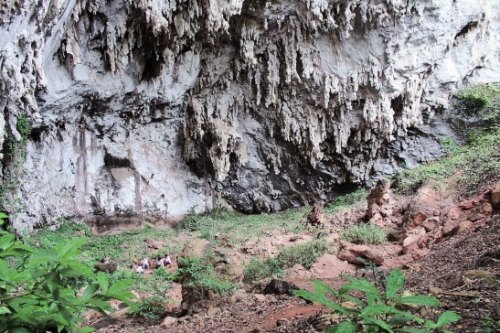
Xiaodong Rockshelter (Photo/Institute of Cultural Relics and Archaeology of Yunnan)
The oldest Hoabinhian culture, an important technological adaptation by hunter-gatherers to the humid tropical and subtropical environments of southeast Asia some 43,500 years ago, was identified in southwest China's Yunnan Province.
Discovered at Xiaodong Rockshelter, it is the first-ever Hoabinhian site to be found in China, according to a research team at the Yunnan Institute of Cultural Relics and Archaeology.
The Hoabinhian culture was first discovered in the 1920s in the northern Vietnam's Hoa Binh Province by French scholar M. Colani, who defined it in 1932 at the First Conference for Prehistoric Archaeologists in the Far East.
The Hoabinhian technocomplex is characterized by large and elongated adze-like unifacial cobble tools, which are thought to be used for woodworking in forested habitats, including the hilly limestone landscapes where the Xiaodong Rockshelter is located.
Leading researcher Ji Xueping said most known Hoabinhian sites have been dated to between 25,000 to 5,000 years ago, with the oldest about 29,000 years from today.
As a technological adaptation practiced by the latest hunter-gatherers to cope with the humid environments of southeast Asia, Hoabinhian sites provide significant clues for understanding the surviving strategies of hominids, and the transition from nomadic populations to more settled agricultural communities, Ji said.
The Xiaodong Palaeolithic site was first found in 1981. In 2004, archaeologists conducted the first systematic investigation in the Xiaodong Cave and collected stone artifacts, which made them realize the value of the site.
From 2007 to 2015, further investigations were carried out at the site. A soil layer containing more than four meters of cultural deposits was excavated. Collected samples confirmed the Hoabinhian affinity of Xiaodong after comparisons with other materials in southeast Asian countries.
The carbon 14 dating method shows the site was occupied some 43,500 to 24,000 years ago. The bottom layer may even be older.
"Xiaodong can be regarded as a typical early Hoabinhian site, the first such site found in China and currently the oldest in Asia as well," Ji said, adding the new discovery may indicate the origins of the widespread Hoabinhian sites in southeast Asia are likely to be in the upper valley region of the Lancang-Mekong river system of southwest China.
"The study shows that the Lancang River valley is a possible home for the Hoabinhian culture and a source of migration for modern humans and the transmission of their culture to southeast Asia," Ji said. "The early Hoabinhian adaptation in southwest Yunnan played an important role in the Late Palaeolithic and Early Neolithic cultures in southeast Asia and south China."
The research team has spent nearly ten years on field investigations that covered tens of thousands of kilometers, and paid several visits to southeast Asian countries for comparative studies. Scholars from France and South Africa also participated in the study.
The finding results have been published online in the journal "Quaternary International" on Dec. 23.


















































